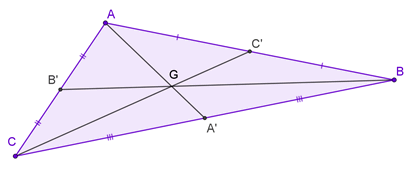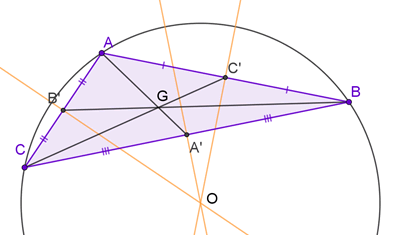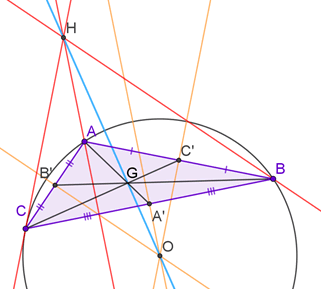Droite d'Euler et démonstrations
Attachons-nous ici à une propriété des triangles non équilatéraux, découverte (ou plutôt redécouverte) par le grand mathématicien suisse Leonhard Euler.
Centre de gravité
D’abord, nous allons démontrer que les trois médianes d’un triangle concourent en un même point : le centre de gravité du triangle (ou isobarycentre). La démonstration s’appuie sur le produit scalaire et le niveau de connaissance requis est celui de la première générale.
Soit un triangle \(ABC\) et soit \(G\) un point qui doit vérifier l’égalité \(\overrightarrow {GA} + \overrightarrow {GB} + \overrightarrow {GC} = \overrightarrow 0. \)
Considérons les points \(A’,\) \(B’\) et \(C’,\) milieux respectifs de \([BC],\) \([AC]\) et \([BA].\) Donc \((AA’),\) \((BB’)\) et \((CC’)\) sont les médianes du triangle \(ABC.\)
Réécrivons cette somme grâce à la relation de Chasles.
\(\overrightarrow {GA} + \overrightarrow {GB} + \overrightarrow {GC} \)
\( = \overrightarrow {GA} + \overrightarrow {GA} + \overrightarrow {AB} + \overrightarrow {GA} + \overrightarrow {AC} \)
\( = 3 \overrightarrow {GA} + \overrightarrow {AB} + \overrightarrow {AC} \)
Utilisons pour la seconde fois la relation de Chasles.
\(= 3 \overrightarrow {GA} + \overrightarrow {AA’} + \overrightarrow {A’B} + \overrightarrow {AA’} + \overrightarrow {A’C}\)
\(= 3 \overrightarrow {GA} + 2 \overrightarrow {AA’} + \overrightarrow {A’B} + \overrightarrow {A’C}\)
Comme \(A’\) est le milieu de \([BC],\) les vecteurs \(\overrightarrow {A’B}\) et \(\overrightarrow {A’C}\) sont opposés. Donc \(\overrightarrow {A’B} + \overrightarrow {A’C} = \overrightarrow 0. \)
Ainsi : \(\overrightarrow {GA} + \overrightarrow {GB} + \overrightarrow {GC} = 3 \overrightarrow {GA} + 2 \overrightarrow {AA’}\)
Si \(\overrightarrow {GA} + \overrightarrow {GB} + \overrightarrow {GC} = \overrightarrow 0 \) alors \(3 \overrightarrow {GA} + 2 \overrightarrow {AA’} = 0\)
Donc \(\overrightarrow {AG} = \frac{2}{3} \overrightarrow {AA’}\)
Nous avons montré qu’il existe un unique point \(G\).
Si l’on reproduit le raisonnement, on obtient de la même manière \(\overrightarrow {BG} = \frac{2}{3} \overrightarrow {BB’}\) et \(\overrightarrow {CG} = \frac{2}{3} \overrightarrow {CC’}\)
On a donc non seulement démontré qu’il existe un unique point \(G\) tel que \(\overrightarrow {GA} + \overrightarrow {GB} + \overrightarrow {GC} = \overrightarrow 0 \) mais aussi que \(G\) est le point où concourent les trois médianes d’un triangle (ci-dessous, construction avec GeoGebra).

Orthocentre et centre du cercle circonscrit
Soit \(O\) le centre du cercle circonscrit (autrement dit, \(AO = BO = CO\)). Rappelons que, par propriété, c’est aussi le lieu où concourent les trois médiatrices du triangle.

Soit un point \(H\) tel que \(\overrightarrow {OH}\) \(= \overrightarrow {OA} + \overrightarrow {OB} + \overrightarrow {OC}.\) Nous ne démontrerons pas cette propriété.
Avec le secours de la relation de Chasles, notre égalité peut s’écrire ainsi :
\(\overrightarrow {OA} + \overrightarrow {AH}\) \( = \overrightarrow {OA} + \overrightarrow {OA’} +\overrightarrow {A’B} + \overrightarrow {OA’} + \overrightarrow {A’C}\)
\(⇔ \overrightarrow {AH} = 2\overrightarrow {OA’} + \overrightarrow {A’B} + \overrightarrow {A’C}\)
\(⇔ \overrightarrow {AH} = 2\overrightarrow {OA’}\)
Comme \((OA’)\) est la médiatrice de \((BC)\) alors \(\overrightarrow {OA’}\) est orthogonal à \(\overrightarrow {BC}\) et comme \(\overrightarrow {OA’}\) et \(\overrightarrow {AH}\) sont colinéaires, \(\overrightarrow {AH}\) est aussi orthogonal à \(\overrightarrow {BC}\). Et si la droite \((AH)\) est perpendiculaire à \((BC)\), alors \(H\) appartient à la hauteur issue de \(A\) (ce qui est réjouissant).
Le même raisonnement conduit à \(H\) appartenant aux hauteurs issues de \(B\) et de \(C.\)
C’est donc le point où concourent les trois hauteurs. Il est appelé orthocentre.
Alignement
Nous avons d’abord vu que le centre de gravité \(G\) vérifiait l’égalité \(\overrightarrow {GA} + \overrightarrow {GB} + \overrightarrow {GC} = \overrightarrow 0. \)
Puis nous avons appris que \(\overrightarrow {OH}\) \(= \overrightarrow {OA} + \overrightarrow {OB} + \overrightarrow {OC}.\)
Nous avons beaucoup utilisé la relation de Chasles mais elle peut encore servir. Synthétisons ces deux égalités.
\(\overrightarrow {OH}\) \(= \overrightarrow {OG} + \overrightarrow {GA} + \overrightarrow {OG} + \overrightarrow {GB} + \overrightarrow {OG} + \overrightarrow {OC}\)
\(⇔ \overrightarrow {OH}\) \(= 3\overrightarrow {OG}\)
Les vecteurs \(\overrightarrow {OH}\) et \(\overrightarrow {OG}\) sont colinéaires. Donc les points \(O,\) \(G\) et \(H\) sont alignés.
La droite qui les relie est appelée droite d’Euler. Dans l’exemple ci-dessous, où \(H\) et \(O\) se situent à l’extérieur du triangle (ce qui n’est pas toujours le cas !), elle figure en bleu.

